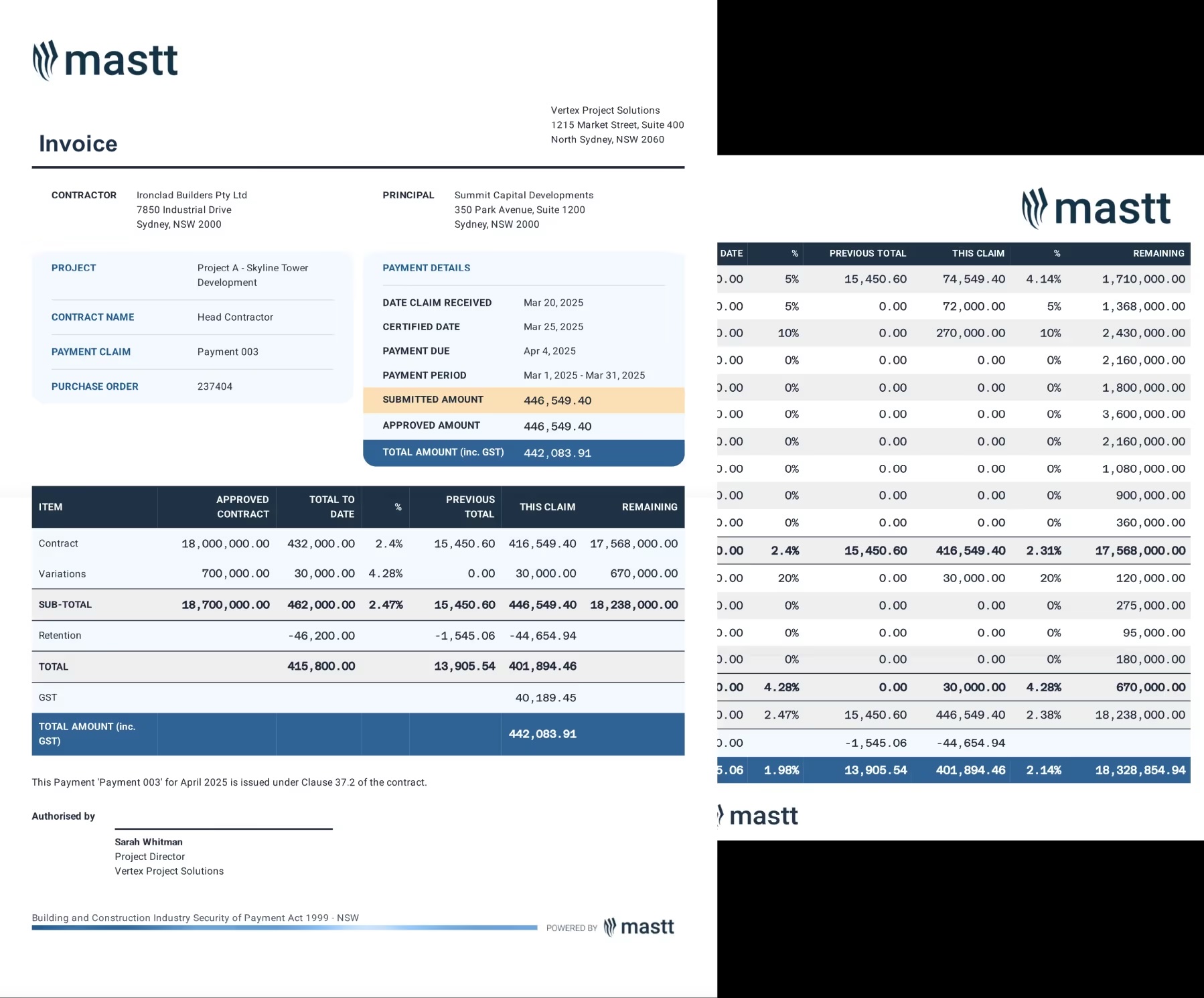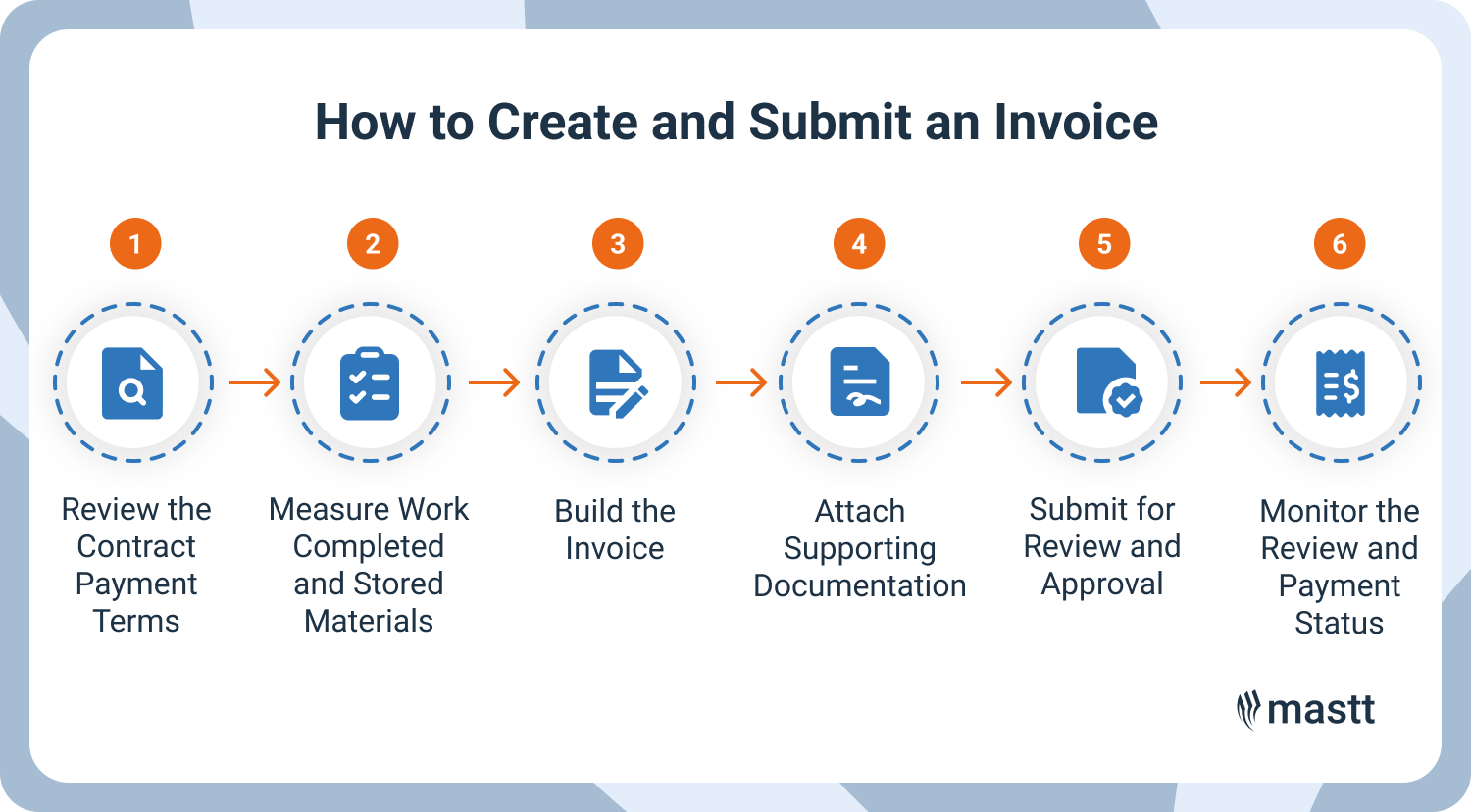Construction invoicing is the process of billing for completed work and materials. Learn how it works and get practical tips to speed up payments.

Use this FREE Construction Invoice Template to simplify billing, track payments, and keep financial records aligned with project contracts.

Construction invoicing refers to the process by which contractors bill for work completed, materials used, and services provided on a project. It’s more detailed than a standard invoice, often backed by documentation to show proof of work and support payment requests.
In this guide, you’ll learn how construction invoicing works from start to finish. We’ll cover the primary invoicing methods used in the industry, the key components of an invoice, and best practices that help contractors simplify and expedite the process.
Construction invoicing is the process of billing for completed work, materials supplied, and services delivered during a specific period of a construction project. It’s a formal payment request that shows the value of work performed and the amount due based on the contract terms and conditions.
Unlike a standard business invoice, a construction invoice includes detailed line items for labor, materials, and equipment, plus supporting documents such as change orders, receipts, and timesheets. These details help confirm project progress and ensure payments align with the work completed.
Construction invoicing also fits into a larger invoice management system that tracks approvals, payment status, and project budgets. This system keeps everyone accountable, supports accurate financial reporting, and helps prevent payment disputes.
A construction invoice is a straightforward bill for work completed or materials provided, while a payment application is a formal, document-heavy request used mainly on larger or public projects where proof of progress is required.
In short, payment applications follow strict contract and documentation standards to ensure accuracy and compliance. They protect all parties by providing a clear record of progress and payments made. Contractors and subcontractors must ensure all supporting documents match the claimed work to avoid delays in the approval or rejection of payment.
Construction invoicing keeps a project’s financial health on track. It ensures everyone gets paid for completed work and provides proof of progress when disputes arise. Without accurate invoicing, even a well-run project can face payment delays, strained relationships, or compliance issues.
Here’s why it matters:
Strong invoicing practices also help contractors forecast upcoming costs, plan resources, and maintain healthy margins. In large projects, consistent invoicing gives owners and project managers the visibility they need to monitor performance against budget and schedule.
Construction invoicing engages multiple parties who each play a role in preparing, reviewing, and approving payments. Each step depends on accurate documentation and clear communication between these roles.
💡Pro Tip: Set up a shared invoice management platform early in the project. When subcontractors, contractors, and accounting teams use one system to upload, track, and approve invoices, payment bottlenecks drop significantly, and so do disputes.

Construction projects use different billing methods depending on the contract type, project size, and payment schedule. Construction invoicing methods determine how payments are structured, calculated, and approved throughout a project.
Contractors should document every billed item in real-time, no matter the invoicing method. Accurate daily tracking makes it easier to justify costs, reduce disputes, and streamline reviews when invoices move through the invoice management system.
A construction invoice includes several key details that verify completed work and ensure accurate, timely payment. Each part must align with the contract and supporting records to keep the review and approval process smooth.
💡Pro Tip: Use a construction invoice template to keep your billing consistent and compliant across all projects. Mastt offers a ready-to-go format used to create accurate, professional invoices that align with contract terms and speed up approval.
To create an invoice in construction, contractors follow a structured process that ensures every detail aligns with the contract. It starts with gathering documentation, updating progress values, and verifying costs before submission.
Before billing, confirm how and when payment can be requested. Most construction contracts outline the invoicing schedule, format, required documentation, retainage rates, and the approval workflow. Knowing these details up front prevents rework and delays later.
Work with the site team to verify the percentage of work completed and identify materials stored on-site or off-site that qualify for billing. These values should align with the project’s schedule of values so that each line item correctly reflects progress and cost.
Prepare the invoice according to the contract’s requirements. Include the project name, billing period, contract number, and cost breakdowns for labor, materials, equipment, and approved change orders. Each billed amount should reconcile with the updated schedule of values and progress documentation.
Owners and project managers rely on documentation to validate the invoice. Attach progress photos, delivery receipts, change order approvals, lien waivers, and timesheets. For public projects, certified payroll reports may also be required. Missing or incomplete attachments are a leading cause of payment delays.
Send the invoice through the designated platform or delivery method by the contract’s cut-off date. Some owners use digital systems for tracking and approval. Timely submission ensures your invoice enters the current billing cycle rather than rolling to the next.
Once submitted, monitor the approval process closely. Stay in contact with the owner’s representative or architect to confirm when the invoice has been reviewed, approved, and released for payment. Keep a record of submission and approval dates to support cash flow forecasting and follow up if payment lags.
The entire invoicing process depends on accuracy, timing, and communication between all project parties. When invoices are consistent and well-documented, payments move faster and disputes are far less likely.

One of the most common problems in construction invoicing is missing or incomplete documentation. Other challenges often come from inaccurate data, late submissions, and unclear communication between teams.
Here are the most frequent invoicing problems contractors face and the best practices to prevent them:
💡 Pro Tip: Integrate AI review tools directly into your invoicing workflow. When AI runs compliance and accuracy checks the moment an invoice is generated, you eliminate rework, reduce rejection rates, and create a verified audit trail that speeds up payment approval.
To simplify construction invoicing, contractors need a structured workflow that eliminates manual steps, reduces errors, and speeds up approvals. The goal is to make every invoice clear, compliant, and easy to verify before it reaches the project owner.
1. Standardize Your Invoicing Format
Use a single, consistent invoice template across all projects. Include the same data fields to make reviews easier and minimize errors. A standardized layout also helps accounting teams and project owners process invoices faster.
2. Centralize Documentation
Keep all supporting files, such as change orders, lien waivers, and daily reports, in one shared folder or an invoice management system. Centralized documentation ensures nothing gets lost and makes it easy for reviewers to verify each billing period’s progress.
3. Automate with Software Tools
Adopt a construction invoicing or project management platform that connects field updates with accounting records. Automation reduces manual entry, prevents duplication, and keeps billing aligned with real project data. Integration between invoicing and accounting tools also helps track retainage and approvals in real time.
4. Review Invoices with AI Before Submission
Contractors should always use AI to review their invoices before sending them to the project owner. Tools like Mastt’s AI Payment Review automatically check compliance, detect missing documentation, and flag inconsistencies that could lead to rejection. This quick step prevents delays and improves approval accuracy.
5. Improve Team Communication
Set up a clear review workflow between subcontractors, general contractors, and owners. Regular updates on billing cycles and approval status keep everyone aligned and prevent back-and-forth during payment review.
6. Track Key Metrics
Monitor metrics like approval time, payment turnaround, and average rejection rate. These insights help identify areas for improvement in your process and guide future project enhancements.
Using automation and AI review tools ensures accuracy and compliance before invoices even reach the client. That means fewer rejections, faster approvals, and steadier cash flow.
Good invoicing reflects the accuracy, discipline, and professionalism behind the construction work, not just the numbers on a form. Contractors who treat invoicing as a control tool gain real visibility into progress and cost. And with AI now reviewing invoices faster than any spreadsheet ever could, there’s no reason payments should slow a project down.

Cut the stress of showing up unprepared
Start for FreeTrusted by the bold, the brave, and the brilliant to deliver the future